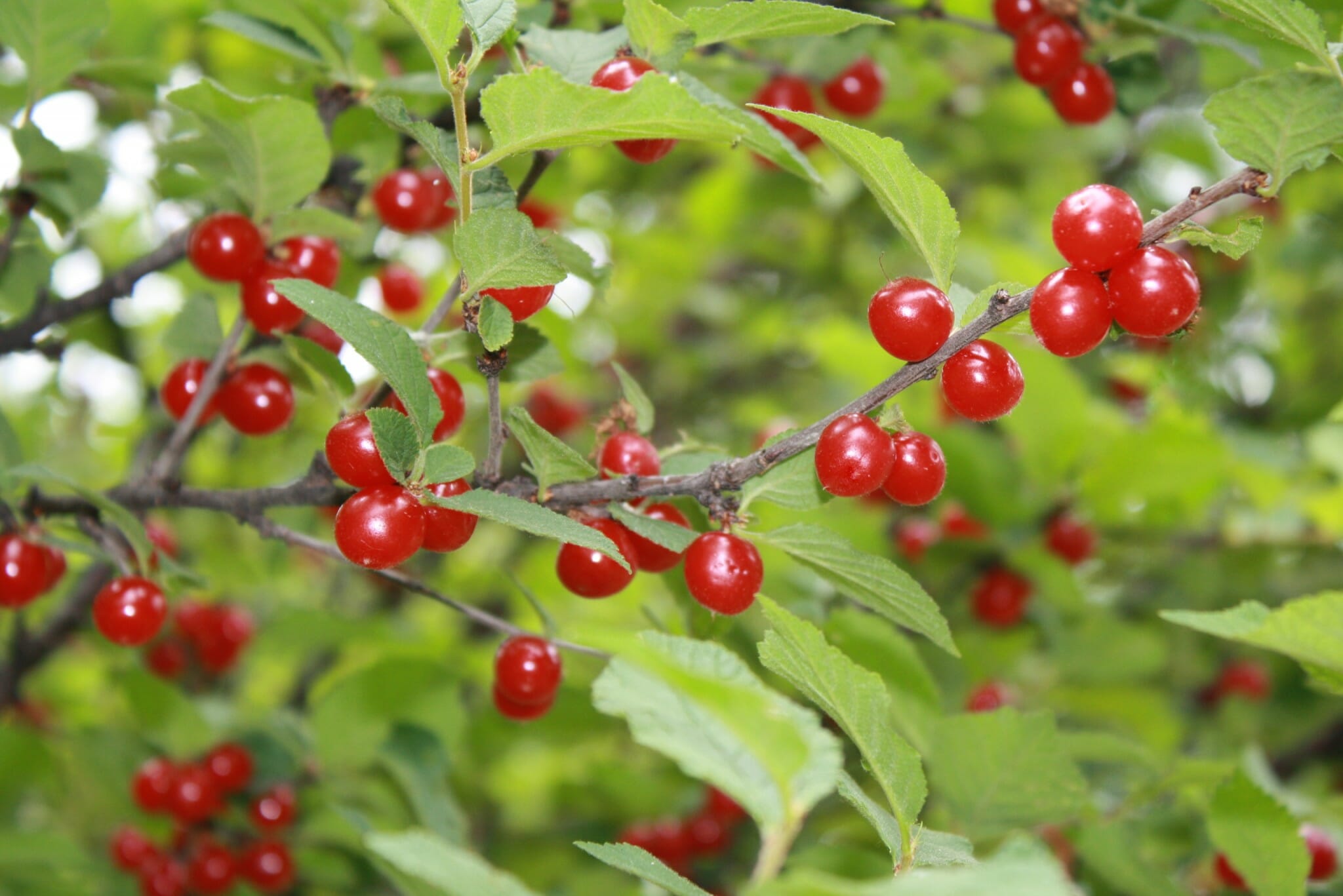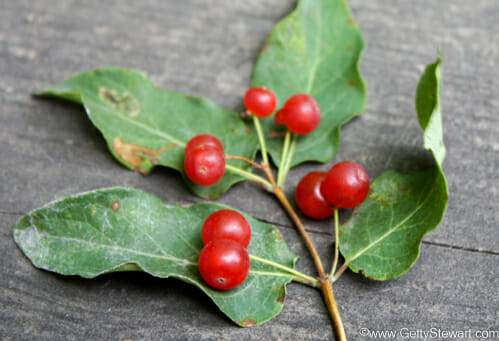Red cherry-like berries growing on trees provide a pop of color in gardens and landscapes. The vibrant fruits also offer tasty treats for wildlife and humans. However, while some red berry trees produce edible fruits, others bear poisonous berries. So it’s essential to accurately identify trees with cherry-like red berries before sampling them.
This article provides an overview of trees with red fruits resembling cherries. We’ll look at identifying features, growth habits hardiness zones and edibility. Let’s explore some of the most popular options to consider planting in your yard.
Cherry Trees
True cherry trees belong to the genus Prunus. There are over 430 species, including popular fruiting trees like sweet cherry (Prunus avium) and sour cherry (Prunus cerasus). The drupes they produce resemble small cherries in shape, texture, and taste.
Cherry trees bloom in spring with white or pink flowers. The blossoms give way to shiny red fruits during summer. Popular ornamental cherry trees include Kwanzan cherry, Yoshino cherry and weeping cherry.
All cherry tree fruits are edible However, flavor ranges from sugary sweet black cherries to lip-puckering sour red cherries Use them fresh or cooked in pies, jams, juices, and wine.
Cherries do best in full sun and well-draining soil. Dwarf varieties thrive in containers. Depending on the species, standard cherry trees reach 15-35 feet tall and most tolerate light shade. Grow cherries in USDA Hardiness Zones 3-9.
Chokecherry
Chokecherry (Prunus virginiana) produces clusters of tart red drupes resembling tiny cherries. The sour berries measure around 1⁄2 inch wide and contain a single large seed.
This small, suckering tree or large shrub grows up to 30 feet tall. It has fragrant white flowers in spring and smooth gray bark. The leaves turn brilliant shades of orange and red in fall.
Chokecherry berries are very acidic when unripe. Once mature, they make tasty jams, juices, syrups, and wine. Just be sure to cook or freeze the cherries first to destroy toxins.
For best growth, plant chokecherry trees in full sun or partial shade. They tolerate most soil conditions and thrive in USDA Zones 2-7.
Cornelian Cherry Dogwood
Dogwood trees in the genus Cornus produce small red cherry-like drupes. The most popular is Cornelian cherry dogwood (Cornus mas).
This small tree or large multi-stemmed shrub grows 16-40 feet tall. It blooms in early spring with clusters of tiny yellow flowers. The flowers give way to glossy oblong red fruits in late summer.
The sour cherry-like dogwood berries measure around 1⁄2 inch long. They contain a single seed. Use the fruits to make jams, juices, sauces, and wine.
Cornelian cherry dogwood thrives in full sun or partial shade. It adapts to various soil types and grows in USDA Hardiness Zones 5-8.
Firethorn
Firethorn (Pyracantha) shrubs produce prolific clusters of red berries resembling tiny cherries. Species like Pyracantha coccinea have sharp thorns along their branches.
During spring, firethorn shrubs bloom with dense white flowers. The blossoms develop into masses of 1⁄4 inch wide red berries in fall. The fruits persist through winter, providing great seasonal interest.
Firethorn berries are bitter and bland. Birds love feasting on them, but they aren’t recommended for human consumption.
For optimal growth, plant firethorns in full sun or partial shade and well-draining soil. They adapt to various conditions and thrive in USDA Zones 5-9. Firethorn shrubs reach 6-12 feet tall.
Hawthorn
Hawthorns are small, thorny trees in the genus Crataegus. They produce abundant pomes resembling tiny red cherries. The fruits measure around 1⁄2 inch wide and contain seeds similar to apple pips.
Popular species include English hawthorn (Crataegus laevigata) and Washington hawthorn (Crataegus phaenopyrum). Both produce fragrant spring blooms and vivid fall foliage.
Hawthorn pomes are quite sour. Cook them into jams, jellies, sauces, fruit leather, and wine. Just remove the seeds first, as they contain toxins like cyanide.
For best growth, plant hawthorn trees in full sun to partial shade and moist, well-draining soil. They adapt to various conditions and thrive in USDA Zones 3-8. Mature size is 15-30 feet for most species.
Mountain Ash
Mountain ashes are small ornamental trees that produce clusters of red berries. The European mountain ash (Sorbus aucuparia) is the most popular. It bears bright red fruits known as “rowanberries.”
Mountain ashes bloom in spring with white flower clusters. The fruits appear in late summer and persist into winter. The trees also have pretty fall colors.
Rowanberries are quite tart. You can make them into jams, jellies, and wine if you add plenty of sugar to counter the bitter taste. It’s best to cook or freeze the fruits first.
For optimal growth, select a spot with full sun or partial shade and moist, acidic soil. Mountain ashes thrive in USDA Zones 3-7 and reach heights of 20-40 feet.
Toyon
Toyon (Heteromeles arbutifolia) is an evergreen shrub native to California. It produces eye-catching clusters of red cherry-like berries. The fruits measure around 1⁄3 inch wide.
Toyon shrubs bloom in early summer with small white flowers. The blossoms give way to abundant berries in late summer/fall. The foliage provides year-round interest.
The fruits resemble tiny red apples in appearance. Toyon berries are edible when fully ripe. They have a cherry-like flavor but contain gritty seeds. Use them cooked into jams and pies.
For optimal growth, plant toyon shrubs in full sun or partial shade. They require good drainage and minimal watering once established. Toyon adapts to various soil types and thrives in USDA Zones 7-10. It reaches 6-15 feet tall.
Crabapples
Flowering crabapple trees (Malus) produce pretty cherry-like fruits. The pomes range in size and color. Popular varieties like ‘Radiant’ and ‘Indian Magic’ have fruits that start out cherry red when unripe, turning dark red or purple when mature.
Crabapples bloom profusely in spring with white, pink, or red flowers. The trees provide multi-season interest with their blooms, fruit, and fall foliage.
The berry-like pomes are edible but often sour. It’s best to cook them into jellies, juices, sauces, and wine. Just remove the seeds first, as they contain trace amounts of cyanide.
For best growth, select a spot with full sun and moist, well-draining soil. Crabapples adapt to various conditions and thrive in USDA Zones 4-8. They reach heights of 10-25 feet.
How to Identify Edible Red Cherry-Like Tree Berries
It’s essential to accurately identify trees before sampling unfamiliar berries. Some ornamental varieties aren’t edible. Others contain poisonous compounds that must be cooked before eating.
Here are some tips for identifying edible red cherry-like tree berries:
-
Examine the leaves, flowers, bark, height, and form to help pinpoint the tree species.
-
Research whether the berries are edible from reliable sources. Never eat unknown berries.
-
Look for chokecherries, cherries, hawthorns, mountain ashes, toyon, and crabapples for tasty fruits.
-
Avoid red berries from hollies, yews, buckthorns, and other poisonous plants. Also don’t eat unripe fruits.
-
When in doubt, stick to enjoying the tree’s beauty and leave the berries for the birds!
With this overview, you now have the knowledge to identify and plant fantastic trees with red cherry-like berries. Consider adding one or more of these charming options to your landscape!

Tartarian or Bush Honeysuckle – Not Edible
These are a bush honeysuckle and they are NOT edible, which is just as well because they’re not tasty at all!


Bush honeysuckles are dense, upright shrubs that can grow 3 to 10 feet. The leaves are a bluish-green and grow in alternate pairs. The small fruit, which goes from green to orange to red, grows on stems in pairs. They ripen in late July and can be quite showy. Not even the birds like these honeysuckle berries.

Red Currants – Edible
These waist high bushes produce strings of small red fruit about 1/2 cm in diameter. You’ll find 5-8 or 10 little red berries along the green stem. The berries or currants are edible but tart. They’re great in pancake, bannock, cake and especially in jelly.
Red currants or Ribes triste are also called swamp currant or wild red currant. It is a member of the gooseberry family.

Caution! Don’t get red currant mixed up with skunk currant (Ribes glandulosum) which grows in wet areas but looks very similar in appearance to red currant. The leaves of skunk currant are less rounded and look more like a maple leaf and the berries are dark red with tiny little hairs on them. They are edible – but they do taste like skunk unless you get them at exactly the right ripeness. Before tasting – crush the leaves – if you smell skunk – avoid the berries.
The Strawberry Tree – Produces fruit that looks like cherries and tastes like cotton candy!
FAQ
Can you eat red honeysuckle berries?
However, caution is warranted when it comes to the berries. These small fruits are not for snacking and can cause stomach upset if consumed in significant amounts. Symptoms to watch for include vomiting, diarrhea, and possibly an irregular heartbeat.
What are the trees with red berries called?
Popular trees that have red berries in summer include cherry trees, mulberries and juneberries, while hawthorns tend to start developing berries in the summer.
Can you eat red berry tree?
Various tiny red berries are safe for consumption, and you can eat them when you find them in your garden.
What does a cherry tree look like?
The Evans cherry tree can be recognized by the bright red berry-like fruit it produces in mid-summer. The small tree bears vibrant red cherry fruits, which grow in dangling clusters. Similar to all cherry types, the red fruits contain a large stone at their center.
What tree has red berries?
The Peruvian pepper is an evergreen tree that bears red berries. It can be identified by its pinnate fern-like leaves, small white flowers, and small dark red berry-like fruit containing peppery red or pink woody seeds. 5. Cornelian Cherry Dogwood Botanical Name: Cornus mas
Do cherry trees produce red berries?
cherry trees in the genus Prunus produce stunning spring blossoms and delicious red edible fruits. Additionally, cherries come in different colors, including yellow, red, crimson red, or deep red. 2. Pin Cherries Botanical Name: Prunus pensylvanica The pine cherry produces red berries in late summer or early fall and grows to a height of.
Which trees have red berries in summer?
Popular trees that have red berries in summer include cherry trees, mulberries and juneberries, while hawthorns tend to start developing berries in the summer. Design expertise in your inbox – from inspiring decorating ideas and beautiful celebrity homes to practical gardening advice and shopping round-ups.
What does a pin cherry tree look like?
Pin Cherry (Prunus pensylvanica) The pin cherry is a small tree with pointed leaves that produce red berries in late summer or early fall. The tree grows to between 16 and 98 ft. (5 – 15 m) in height and can be identified by its round-topped crown, and its lanceolate leaves that grow alternately on long reddish thin stems.
Do cherries ripen in the summer?
‘Cherry trees are one of my all-time favorite trees with red ‘berries’. Not only do they produce delicious fruit, but the flowers are beautiful too,’ says Barbosa Fernandes. Unlike many of the other trees featured in this list, cherries ripen during the summer.
